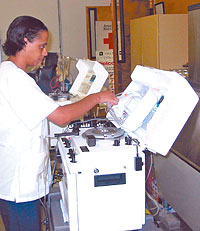Red Cross blood-giving procedure removes red cells, returns the rest
By Becky Barclay
Published in News on August 30, 2004 1:57 PM
For the last year, the Wayne County Red Cross has been performing a blood-donation procedure that is easier for the donor, eliminating the weakness sometimes associated with giving blood.
The Wayne County chapter is using a new process by which donors can give a "double red cell donation" at one sitting. The chapter has collected about 100 units of blood this way, said Don Best, blood services director.

News-Argus/Becky Barclay
Technician Regina Mitchell prepares the double red cell machine for a donor.
Best explained the double red cell donation process saying blood is composed of red cells, platelets and plasma. During a regular donation, one unit of whole blood is taken and separated into the three different components at a processing center.
The new machine takes a unit of whole blood from the donor, spins it in a centrifuge and separates the red cells from the platelets and plasma. The red cells go into one bag and everything else goes into another.
Then the machine, without having to do another puncture, automatically reverses itself and puts the plasma mixed with saline back into the donor.
When the plasma bag is empty, the machine automatically reverses itself again and takes the second unit of whole blood from the donor. The second bag goes through the same process as the first and again the plasma mixed with saline is put back into the donor.
Best said the entire process takes about 30 minutes.
He also stressed that the donor is not losing the volume of blood that he would with a regular donation. And only one needle is used, which is smaller than the one used for a whole blood donation.
But there are certain requirements for a double red cell donation. A woman must be at least 17 years old and 5 feet 5 inches tall, weigh at least 175 pounds and have at least a 40 percent iron level.
A man must be at least 17 and 5-feet-1, weigh at least 150 pounds and have at least a 40 percent iron level.
Best said this criterion is higher than it is for a regular blood donation.
The machine is used only for people with blood types O and B, according to Best. He said those are the types that are used more often.
"This is primarily set up for people who only give once or twice at year," said Best. "Once you donate double red cells, you must wait 112 days before giving again. For a standard donation, the donor must wait 56 days.
"That's because red blood cells reproduce in the body after about five to six weeks. The volume replaces itself within 24 to 48 hours. When a double red cell donation is taken, it takes double the time for the cells to regenerate themselves."
Best has given a double red cell donation and said it's easier than doing a regular blood donation. "Actually, I think it was a little better than a regular donation because when I got through, I didn't feel weak," he said. "I didn't lose that volume so my blood pressure stayed more equal than it does with a regular donation."
He noted that an adult has between 11 and 12 pints of blood. "With a regular donation, we're taking one of those pints," he said. "With a double red cell donation, we're not really taking hardly any because we're giving back the plasma with saline. So the donor is losing less than a half a pint of blood."
Best said the Red Cross can get about three units of double red cells during one blood drive because the machine has to be cleaned, sterilized and reset between donors, which takes about half an hour.
He stressed that it's perfectly safe to give a double red cell donation because a new needle is used for each donor. And donors don't have to take any extra precautions.
Best said the double red cell donation is a more efficient way of collecting blood because red cells are used more often then are plasma and platelets. So the Red Cross wants to get as much red blood cells as it can.
"If a person is getting a transfusion, normally he gets only the red blood cells, not the whole unit of blood," said Best. "Depending on what the problem is, a person may get only plasma or only platelets. Or occasionally he may get all three and if he does, there are three separate bags hanging next to him. He doesn't get all three components in one bag."
Best noted that red blood cells have a 42-day shelf life. Platelets have about a five-day shelf life. Plasma can be frozen indefinitely.
The double red cell donation cannot be done at every blood drive the chapter has because there are only four machines in this service area and one of those stays in Wilmington permanently. The other three are also used at blood drives outside Wayne County.
Anyone who meets the criteria and would like to do a double red cell donation should call the chapter at 735-7201 to schedule an appointment.
